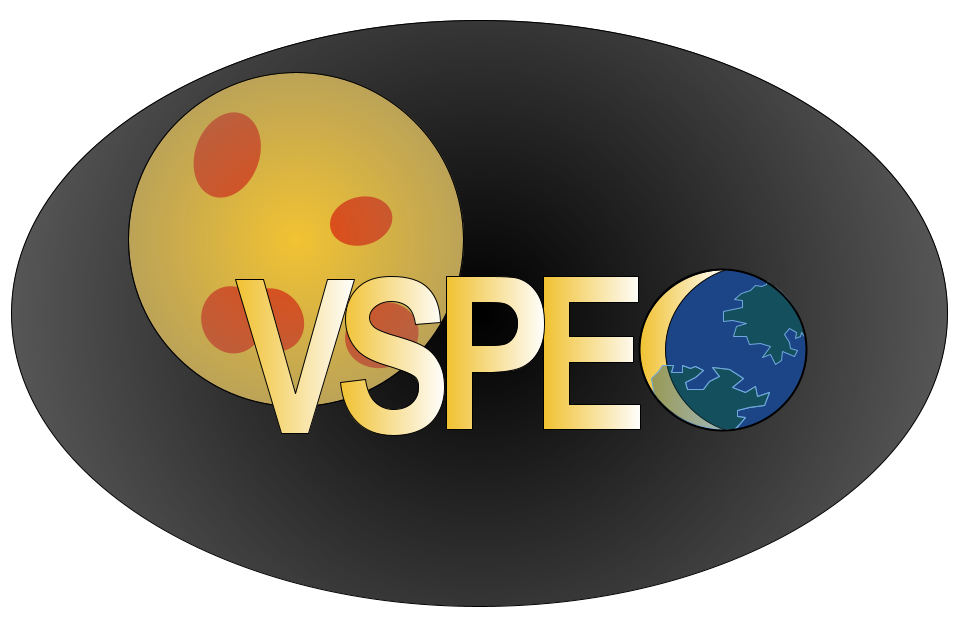Note
Go to the end to download the full example code.
Observe a phase curve of a spotted star.#
This example demonstrates stellar contamination of a phase curve.
A phase curve with a long enough baseline can be contaminated by stellar variability. We take the phase curve of GJ1214 b, analyzed by Kempton et al. [2023] using JWST MIRI-LRS, as an example.
from pathlib import Path
import numpy as np
import matplotlib.pyplot as plt
from astropy import units as u
from cartopy import crs as ccrs
import libpypsg
from libpypsg.globes import PyGCM
from VSPEC import ObservationModel,PhaseAnalyzer
from VSPEC import params
from VSPEC.config import MSH
SEED = 1214
libpypsg.docker.set_url_and_run()
Saved settings to /home/runner/.libpypsg/settings.json
Reloading settings...
Create the configurations#
# Instrument
inst = params.InstrumentParameters.miri_lrs()
# Observation
observation = params.ObservationParameters(
observation_time=41.0*u.hr,
integration_time=15*u.min
)
# PSG
psg_params = params.psgParameters(
gcm_binning=200,
phase_binning=1,
nmax=0,
lmax=0,
use_continuum_stellar=True,
continuum=['Rayleigh', 'Refraction', 'CIA_all'],
use_molecular_signatures=True
)
# Star and Planet
star_teff = 3250*u.K
star_rad = 0.215*u.R_sun
planet_rad = 2.742*u.R_earth
orbit_rad = 0.01490*u.AU
orbit_period = 1.58040433*u.day
planet_rot_period = orbit_period
star_rot_period = 120 * u.day
planet_mass = 8.17*u.M_earth
star_mass = 0.178*u.M_sun
inclination = 88.7*u.deg
start_time_before_eclipse = 2*u.hr
angle_before_eclipse = (2*np.pi*u.rad * start_time_before_eclipse/orbit_period).to(u.deg)
initial_phase = 0*u.deg - angle_before_eclipse
planet_params = params.PlanetParameters(
name='GJ1214b',
radius=planet_rad,
gravity=params.GravityParameters('kg',planet_mass),
semimajor_axis=orbit_rad,
orbit_period=orbit_period,
rotation_period=planet_rot_period,
eccentricity=0,
obliquity=0*u.deg,
obliquity_direction=0*u.deg,
init_phase=initial_phase,
init_substellar_lon=0*u.deg
)
system_params = params.SystemParameters(
distance=14.6427*u.pc,
inclination=inclination,
phase_of_periastron=0*u.deg
)
star_dict = {
'teff': star_teff,
'radius': star_rad
}
planet_dict = {'semimajor_axis': orbit_rad}
gcm_dict = {
'nlayer': 30,
'nlon': 30,
'nlat': 15,
'epsilon': 6,
'albedo': 0.3,
'emissivity': 1.0,
'lat_redistribution': 0.1,
'gamma': 1.4,
'psurf': 1*u.bar,
'ptop': 1e-5*u.bar,
'wind': {'U': '0 m/s','V':'0 m/s'},
'molecules':{'CO2':0.99}
}
gcm = params.gcmParameters.from_dict({
'star':star_dict,
'planet':planet_dict,
'gcm':{'vspec':gcm_dict,'mean_molec_weight':44}
})
star_kwargs = dict(
psg_star_template='M',
teff=star_teff,
mass=star_mass,
radius=star_rad,
period=star_rot_period,
misalignment=0*u.deg,
misalignment_dir=0*u.deg,
ld=params.LimbDarkeningParameters.proxima(),
faculae=params.FaculaParameters.none(),
flares=params.FlareParameters.none(),
granulation=params.GranulationParameters.none(),
grid_params=(500,1000),
)
quiet_star = params.StarParameters(
spots=params.SpotParameters.none(),
**star_kwargs
)
spotted_star = params.StarParameters(
spots=params.SpotParameters(
distribution='iso',
initial_coverage=0.2,
area_mean=300*MSH,
area_logsigma=0.2,
teff_umbra=2700*u.K,
teff_penumbra=2700*u.K,
equillibrium_coverage=0.2,
burn_in=0*u.s,
growth_rate=0.0/u.day,
decay_rate=0*MSH/u.day,
initial_area=10*MSH
),
**star_kwargs
)
# Set parameters for simulation
header_kwargs = dict(
seed = SEED,
verbose = 0,
spec_grid = params.VSPECGridParameters(
max_teff=3400*u.K,min_teff=2300*u.K,
impl_bin='rust',impl_interp='scipy',fail_on_missing=False
)
)
internal_params_kwargs = dict(
planet=planet_params,
system=system_params,
obs=observation,
gcm=gcm,
psg=psg_params,
inst=inst
)
params_quiet = params.InternalParameters(
header=params.Header(data_path=Path('.vspec/gj1214_quiet'),**header_kwargs),
star = quiet_star,
**internal_params_kwargs
)
params_spotted = params.InternalParameters(
header=params.Header(data_path=Path('.vspec/gj1214_spotted'),**header_kwargs),
star = spotted_star,
**internal_params_kwargs
)
Map the planetary surface#
Before we run VSPEC, let’s look at the planet.
gcm_data:PyGCM = gcm.get_gcm()
tsurf = gcm_data.tsurf.dat.to_value(u.K)
fig = plt.figure()
proj = ccrs.Robinson(central_longitude=0)
ax = fig.add_subplot(projection=proj)
lats = gcm_data.lat_start + np.arange(gcm_data.shape[2]+1) * gcm_data.dlat.to_value(u.deg)
lons = gcm_data.lon_start + np.arange(gcm_data.shape[1]+1) * gcm_data.dlon.to_value(u.deg)
im = ax.pcolor(lons,lats,tsurf.T,cmap='gist_heat',transform=ccrs.PlateCarree())
gl = ax.gridlines(crs=ccrs.PlateCarree(),draw_labels=True,
color='grey', alpha=0.8, linestyle='--')
gl.top_xlabels = False
gl.right_ylabels = False
_=fig.colorbar(im,ax=ax,label='Surface Temperature (K)')
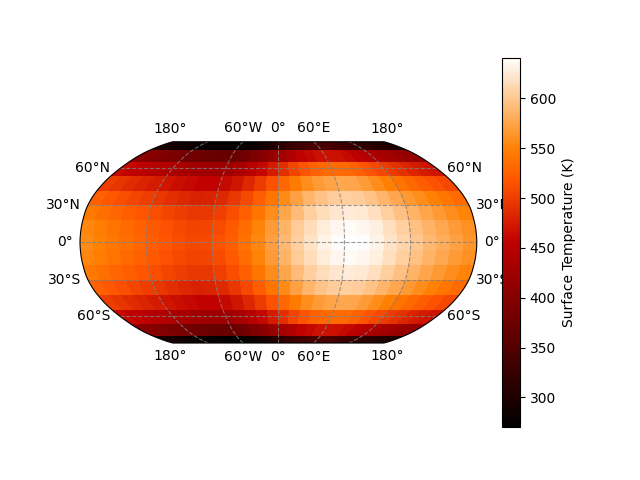
Run the spotless model#
model_quiet = ObservationModel(params=params_quiet)
model_quiet.build_planet()
model_quiet.build_spectra()
Creating interpolators:
thermal
thermal, combined
thermal, combined, stellar
thermal, combined, stellar, photon noise
thermal, combined, stellar, photon noise, detector noise
thermal, combined, stellar, photon noise, detector noise, telescope noise
thermal, combined, stellar, photon noise, detector noise, telescope noise, background noise
thermal, combined, stellar, photon noise, detector noise, telescope noise, background noise, transit
Finished!
Loading Spectra: 0%| | 0/12 [00:00<?, ?it/s]
Loading Spectra: 8%|▊ | 1/12 [00:00<00:03, 3.35it/s]
Loading Spectra: 17%|█▋ | 2/12 [00:00<00:02, 3.35it/s]
Loading Spectra: 25%|██▌ | 3/12 [00:00<00:02, 3.35it/s]
Loading Spectra: 33%|███▎ | 4/12 [00:01<00:02, 3.35it/s]
Loading Spectra: 42%|████▏ | 5/12 [00:01<00:02, 3.35it/s]
Loading Spectra: 50%|█████ | 6/12 [00:01<00:01, 3.36it/s]
Loading Spectra: 58%|█████▊ | 7/12 [00:02<00:01, 3.36it/s]
Loading Spectra: 67%|██████▋ | 8/12 [00:02<00:01, 3.37it/s]
Loading Spectra: 75%|███████▌ | 9/12 [00:02<00:00, 3.36it/s]
Loading Spectra: 83%|████████▎ | 10/12 [00:02<00:00, 3.36it/s]
Loading Spectra: 92%|█████████▏| 11/12 [00:03<00:00, 3.36it/s]
Loading Spectra: 100%|██████████| 12/12 [00:03<00:00, 3.36it/s]
Loading Spectra: 100%|██████████| 12/12 [00:03<00:00, 3.36it/s]
Plot the lightcurve#
data_quiet = PhaseAnalyzer(model_quiet.directories['all_model'])
flux_unit = u.Unit('W m-2 um-1')
def get_star(data:PhaseAnalyzer):
i_eclipse1 = np.argmin(data.lightcurve('total',(0,-1))[:data.n_images//4])
i_eclipse2 = np.argmin(data.lightcurve('total',(0,-1))[3*data.n_images//4:]) + 3*data.n_images//4
time = (data.time-data.time[0]).to_value(u.hr)
star_spec1 = data.spectrum('total',i_eclipse1).to_value(flux_unit)
star_spec2 = data.spectrum('total',i_eclipse2).to_value(flux_unit)
def func(t:float):
m = (star_spec2 - star_spec1)/(time[i_eclipse2]-time[i_eclipse1])
x = t-time[i_eclipse1]
b = star_spec1
y = m * x + b
return y
return func
def plot_lc(data:PhaseAnalyzer):
fig,axes = plt.subplots(2,1,tight_layout=True)
axes[0].scatter((data.time-data.time[0]).to(u.hr),
data.lightcurve('total',(0,-1)),label='white light',s=5,c='k')
axes[0].set_xlabel('Time since start of observation (hour)')
axes[0].set_ylabel('Flux (W m-2 um-1)')
axes[0].legend()
first_four = data.time-data.time[0] <= 4*u.hour
axins = axes[0].inset_axes([0.08, 0.15, 0.35, 0.5])
axins.scatter((data.time-data.time[0]).to(u.hr)[first_four],
data.lightcurve('total',(0,-1))[first_four],label='white light',s=5,c='k')
axes[0].indicate_inset_zoom(axins)
interp = get_star(data)
t = (data.time-data.time[0]).to_value(u.hr)
n_steps = 10
colors = plt.get_cmap('viridis')
indices = np.arange(start=0,stop=data.n_images,step=data.n_images//n_steps)
for index in indices:
star_spec = interp(t[index])
pl_spec = data.spectrum('total',index).to_value(flux_unit) - star_spec
axes[1].plot(data.wavelength,1e6*pl_spec/star_spec,c=colors(index/data.n_images))
axes[1].set_xlabel('Wavelength (um)')
axes[1].set_ylabel('Planet flux (ppm)')
return fig
plot_lc(data_quiet).show()
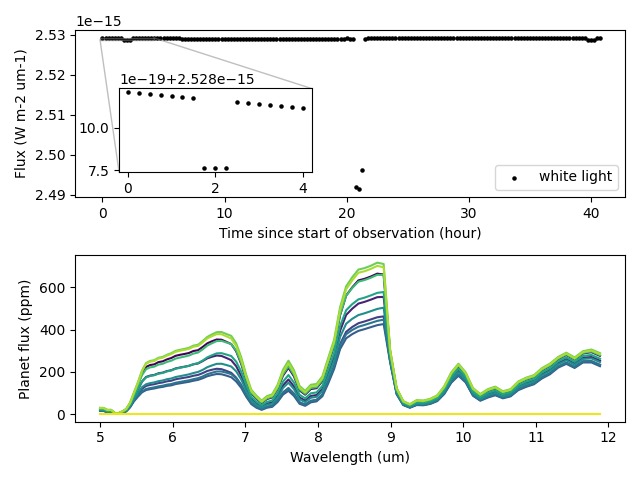
Plot the spectroscopic phase curve#
We can throw out the transit points while we’re at it.
def get_phase_map(data:PhaseAnalyzer):
white_light_curve = data_quiet.lightcurve('total',(0,-1),normalize=0)
points_to_use = white_light_curve > 0.5*(np.median(white_light_curve)+ np.min(white_light_curve))
interp = get_star(data)
ts = (data.time-data.time[0]).to_value(u.hr)
# get the planet flux, except plance nan during transit
star_im = np.array([interp(t) for t in ts]).T
total_im = data.total.to_value(flux_unit)
pl_im = np.where(
points_to_use,
total_im-star_im,
np.nan
)
return pl_im,star_im
def plot_phasecurve(data:PhaseAnalyzer):
pl_im,star_im = get_phase_map(data)
fig,ax = plt.subplots(1,1)
im = ax.pcolormesh(
(data.time-data.time[0]).to_value(u.hr),
data.wavelength.to_value(u.um),
pl_im/star_im*1e6,
cmap='viridis'
)
fig.colorbar(im,ax=ax,label='Planet flux (ppm)')
ax.set_xlabel('Time since start of observation (hour)')
ax.set_ylabel('Wavelength (um)')
return fig
plot_phasecurve(data_quiet).show()
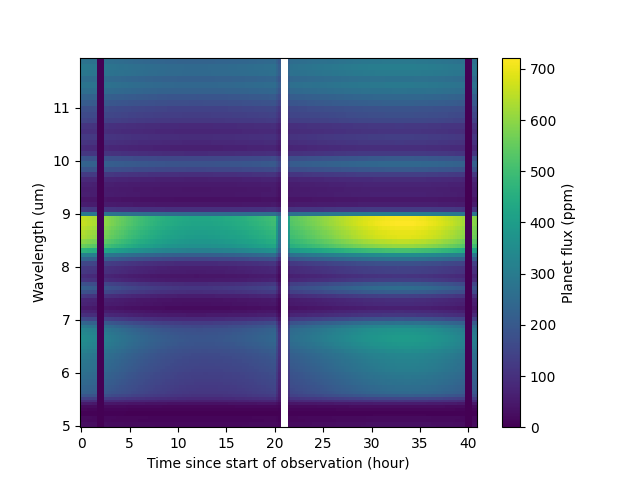
We can easily make out the phase curve because the star is static.
Run the spotted model#
Because we are using the same planet parameters, we won’t rerun PSG for this. Instead, we will just rerun the stellar part of the code. In a way this is cheating but it will save time. Be careful because we are overwriting our old data.
model_spotted = ObservationModel(params_spotted)
model_spotted.build_planet()
model_spotted.build_spectra()
data_spotted = PhaseAnalyzer(model_spotted.directories['all_model'])
Generated 124 mature spots
Creating interpolators:
thermal
thermal, combined
thermal, combined, stellar
thermal, combined, stellar, photon noise
thermal, combined, stellar, photon noise, detector noise
thermal, combined, stellar, photon noise, detector noise, telescope noise
thermal, combined, stellar, photon noise, detector noise, telescope noise, background noise
thermal, combined, stellar, photon noise, detector noise, telescope noise, background noise, transit
Finished!
Loading Spectra: 0%| | 0/12 [00:00<?, ?it/s]
Loading Spectra: 8%|▊ | 1/12 [00:00<00:03, 3.27it/s]
Loading Spectra: 17%|█▋ | 2/12 [00:00<00:03, 3.28it/s]
Loading Spectra: 25%|██▌ | 3/12 [00:00<00:02, 3.29it/s]
Loading Spectra: 33%|███▎ | 4/12 [00:01<00:02, 3.30it/s]
Loading Spectra: 42%|████▏ | 5/12 [00:01<00:02, 3.30it/s]
Loading Spectra: 50%|█████ | 6/12 [00:01<00:01, 3.31it/s]
Loading Spectra: 58%|█████▊ | 7/12 [00:02<00:01, 3.29it/s]
Loading Spectra: 67%|██████▋ | 8/12 [00:02<00:01, 3.30it/s]
Loading Spectra: 75%|███████▌ | 9/12 [00:02<00:00, 3.30it/s]
Loading Spectra: 83%|████████▎ | 10/12 [00:03<00:00, 3.31it/s]
Loading Spectra: 92%|█████████▏| 11/12 [00:03<00:00, 3.31it/s]
Loading Spectra: 100%|██████████| 12/12 [00:03<00:00, 3.31it/s]
Loading Spectra: 100%|██████████| 12/12 [00:03<00:00, 3.30it/s]
Plot the lightcurve, again#
We redo our earlier analysis
plot_lc(data_spotted).show()
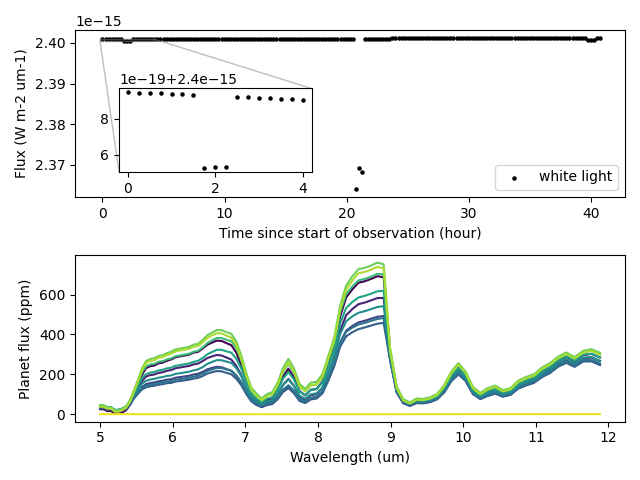
And the phase curve#
plot_phasecurve(data_spotted).show()
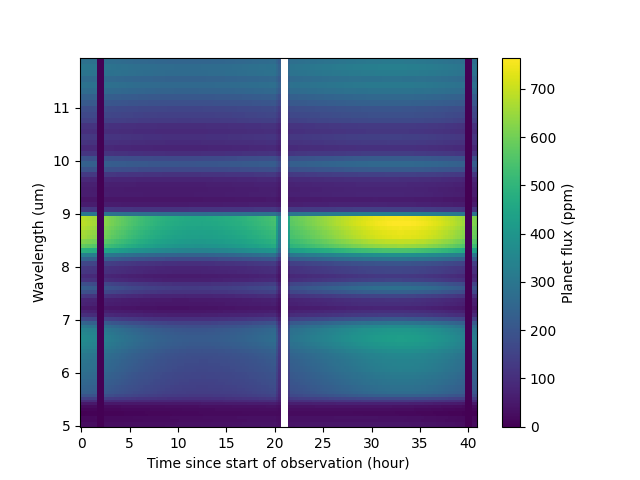
Compare phase curves#
Kempton et al. [2023] break the spectrum up into \(0.5 \mu m\) bins to analyze the phase curve. We will do the same to observe the effects of stellar contamination.
def get_lc(data:PhaseAnalyzer,w1:u.Quantity,w2:u.Quantity):
"""Get the lightcurve given a bandpass"""
wl = data.wavelength
i_left = int(np.argwhere(wl > w1)[0])
try:
i_right = int(np.argwhere(wl > w2)[0])
except IndexError:
i_right = -1
interp = get_star(data)
ts = (data.time-data.time[0]).to_value(u.hr)
star_im = np.array([interp(t) for t in ts]).T
total_im = data.total.to_value(flux_unit)
pl_im = total_im-star_im
lc = 1e6*pl_im[i_left:i_right,:]/star_im[i_left:i_right,:]
return lc.mean(axis=0)
bin_edges = np.arange(5.0,12.0,0.5)
n_ax = len(bin_edges)
fig,axes = plt.subplots(n_ax,1,figsize=(7,10),sharex=True)
for edge,ax in zip(bin_edges,axes):
w1,w2 = edge*u.um,(edge+0.5)*u.um
quiet_lc = get_lc(data_quiet,w1,w2)
spotted_lc = get_lc(data_spotted,w1,w2)
time = (data_quiet.time - data_quiet.time[0]).to(u.hr)
ax.plot(time,(quiet_lc),c='xkcd:azure',label='No Spots')
ax.plot(time,(spotted_lc),c='xkcd:lavender',label='Spotted')
ax.text(0.7,0.7,f'{w1:.1f} - {w2:.1f}',transform=ax.transAxes)
ax.set_ylim(-100,700)
fig.subplots_adjust(hspace=0,wspace=0)
axes[0].legend()
axes[-1].set_xlabel('Time (hour)')
_ = axes[n_ax//2].set_ylabel('Planet Flux (ppm)')
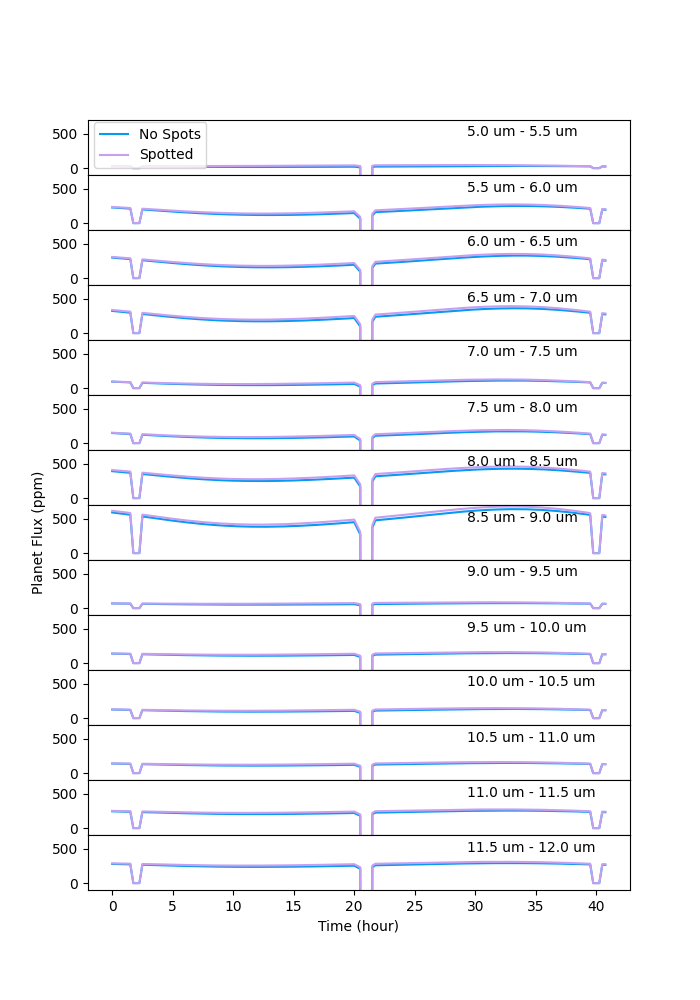
/home/runner/work/VSPEC/VSPEC/examples/end_to_end/plot_gj1214b_kempton23.py:357: DeprecationWarning: Conversion of an array with ndim > 0 to a scalar is deprecated, and will error in future. Ensure you extract a single element from your array before performing this operation. (Deprecated NumPy 1.25.)
i_left = int(np.argwhere(wl > w1)[0])
/home/runner/work/VSPEC/VSPEC/examples/end_to_end/plot_gj1214b_kempton23.py:359: DeprecationWarning: Conversion of an array with ndim > 0 to a scalar is deprecated, and will error in future. Ensure you extract a single element from your array before performing this operation. (Deprecated NumPy 1.25.)
i_right = int(np.argwhere(wl > w2)[0])
2D residuals#
Let’s take a look at how much of the planet flux (from the spotted model) is actaully due to spots.
pl_quiet,star_quiet = get_phase_map(data_quiet)
pl_spotted,_ = get_phase_map(data_spotted)
contribution_from_spots = pl_spotted-pl_quiet
contrast = (contribution_from_spots/star_quiet*1e6)
t = (data_quiet.time - data_quiet.time[0]).to_value(u.hr)
wl = data_quiet.wavelength.to_value(u.um)
fig,ax = plt.subplots(1,1)
im = ax.pcolormesh(t,wl,contrast)
fig.colorbar(im,ax=ax,label='False planet flux (ppm)')
ax.set_xlabel('Time since start of observation (hour)')
_=ax.set_ylabel('Wavelength (um)')

Total running time of the script: (11 minutes 20.780 seconds)
